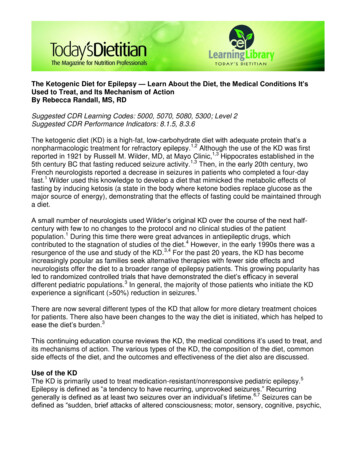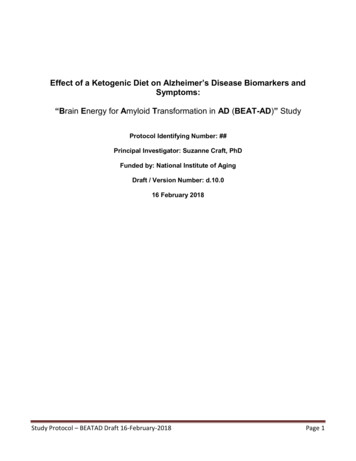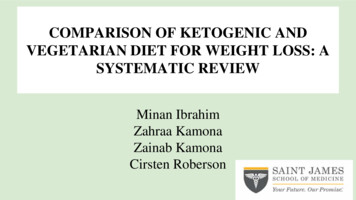
Transcription
The Ketogenic Diet for Epilepsy — Learn About the Diet, the Medical Conditions It’sUsed to Treat, and Its Mechanism of ActionBy Rebecca Randall, MS, RDSuggested CDR Learning Codes: 5000, 5070, 5080, 5300; Level 2Suggested CDR Performance Indicators: 8.1.5, 8.3.6The ketogenic diet (KD) is a high-fat, low-carbohydrate diet with adequate protein that’s anonpharmacologic treatment for refractory epilepsy.1,2 Although the use of the KD was firstreported in 1921 by Russell M. Wilder, MD, at Mayo Clinic,1,3 Hippocrates established in the5th century BC that fasting reduced seizure activity.1,3 Then, in the early 20th century, twoFrench neurologists reported a decrease in seizures in patients who completed a four-dayfast.1 Wilder used this knowledge to develop a diet that mimicked the metabolic effects offasting by inducing ketosis (a state in the body where ketone bodies replace glucose as themajor source of energy), demonstrating that the effects of fasting could be maintained througha diet.A small number of neurologists used Wilder’s original KD over the course of the next halfcentury with few to no changes to the protocol and no clinical studies of the patientpopulation.1 During this time there were great advances in antiepileptic drugs, whichcontributed to the stagnation of studies of the diet.4 However, in the early 1990s there was aresurgence of the use and study of the KD.3,4 For the past 20 years, the KD has becomeincreasingly popular as families seek alternative therapies with fewer side effects andneurologists offer the diet to a broader range of epilepsy patients. This growing popularity hasled to randomized controlled trials that have demonstrated the diet’s efficacy in severaldifferent pediatric populations.3 In general, the majority of those patients who initiate the KDexperience a significant ( 50%) reduction in seizures.1There are now several different types of the KD that allow for more dietary treatment choicesfor patients. There also have been changes to the way the diet is initiated, which has helped toease the diet’s burden.3This continuing education course reviews the KD, the medical conditions it’s used to treat, andits mechanisms of action. The various types of the KD, the composition of the diet, commonside effects of the diet, and the outcomes and effectiveness of the diet also are discussed.Use of the KDThe KD is primarily used to treat medication-resistant/nonresponsive pediatric epilepsy.5Epilepsy is defined as “a tendency to have recurring, unprovoked seizures.” Recurringgenerally is defined as at least two seizures over an individual’s lifetime. 6,7 Seizures can bedefined as “sudden, brief attacks of altered consciousness; motor, sensory, cognitive, psychic,
or autonomic disturbances; or inappropriate behavior caused by abnormal, excessive, orsynchronous neuronal activity in the brain.”7Seizures are categorized into two groups: partial/focal seizures and generalized seizures. 8Partial or focal seizures occur in only one part of the brain and can be simple (no loss ofconsciousness) or complex (loss of consciousness). Generalized seizures occur in both sidesof the brain, often causing loss of consciousness.8Epilepsy is the most common neurological disorder in the world, affecting 3% of the generalglobal population.7 In Western populations, 1 in 2,000 people has epilepsy.7 The incidence ofepilepsy is the highest in the first 12 months of life, and then again after 60 years of age. 7There are multiple epilepsy syndromes, each with different causes, presentations, treatments,and outcomes.5,7,9There’s no definitive research regarding which epileptic syndromes the KD most effectivelytreats. It has been theorized that the KD doesn’t differ in efficacy based on type of seizure orsyndrome.10 During the past decade, more studies have provided additional information on theKD and the populations who benefit from it.The 2008 recommendations of the International Ketogenic Diet Study Group indicate that theKD may be efficacious for the following types of epilepsy: infantile spasms, tuberous sclerosiscomplex, myoclonic-astatic epilepsy (Doose syndrome), severe myoclonic epilepsy of infancy(Dravet syndrome), and Rett syndrome.11,12 Other studies have reported better response to theKD in infantile spasms than in complex partial seizures; two studies in particular have shownthat the KD is effective in severe myoclonic epilepsy in infancy.1,4The 2012 National Institute for Clinical Excellence guidelines recommend that all children withepilepsy who haven’t responded to antiepileptic drugs should be considered for a trial of theKD.5 This recommendation has been reiterated by several other reports, stating that due toincreased access to the KD and its new, less restrictive forms, the diet should be consideredas alternative therapy for children with refractory epilepsy as well as individuals in olderpopulations.7,9The KD also has been used to treat two rare metabolic genetic disorders: pyruvatedehydrogenase deficiency (PDH) and glucose transporter-1 deficiency syndrome (GLUT1).The use of the diet in these populations is a first-line therapy option and can be life saving.11-14Patients with PDH and GLUT1 likely will have to follow the KD for life. This course focuses onlyon the use of the KD in the intractable epilepsy population.Mechanisms of ActionThe specific mechanisms of the KD and how fasting results in a decrease or cessation ofseizures isn’t known. However, major advancements have been made in understanding thediet’s many complex effects on the central nervous system. More research on the mechanismsof action is needed to further validate the KD’s effectiveness. 12 With more information about itsmechanisms, the KD might be deployed in a more focused way and could be further refined.2
What’s known is that when there’s a large decrease in carbohydrate consumption, glucoseutilization is reduced. When this happens, the liver uses fatty acids to produce ketone bodies,such as beta-hydroxybutyrate (BHB) and acetoacetate. These are then used in place ofglucose to provide energy for cellular metabolism.15 The KD replaces glucose as the majorsource of energy with ketone bodies, thus inducing a state of ketosis.16 In the body, a largeamount of energy is used to fuel neurons. In individuals on the KD diet, the elevated ketonebodies inhibit neuronal excitability, slowing the firing rates of neurons, which could decreaseseizure activity.15,16An important question regarding the mechanism of action of the KD, one that currently remainsunanswered, is whether it’s the production of ketone bodies or the decrease in glucose thatdrives the diet’s efficacy.15,16 If ketone bodies are the main contributors to decreased seizures,one would expect to see a correlation with serum ketone concentration and effectiveness.15However, only one study to date has shown improved outcomes with higher serum BHB levels(an indicator of ketone bodies), while several other studies have shown no correlation. 15In addition, newer forms of the KD, which don’t always lead to ketosis, have been shown to beeffective in decreasing seizures.16 Decreased glucose and insulin as a driving factor also issupported by the fact that the diet’s benefits are reversed when glucose is intravenouslyinfused.16There are several theories on the specific mechanisms of action of the KD that won’t bediscussed in this article but demonstrate the substantial progress that has been made in thelast decade regarding the multifaceted mechanism of action of the KD.Types of KDThere are a variety of types of the KD. These are summarized in Table 1.3
Classic KDThe classic KD is the original diet developed more than a century ago and is still the mostprevalent type used today.4 Johns Hopkins Hospital published the original protocol on initiationand maintenance of the diet and advocated for its use only in patients aged 1 to 15. 4 The KDisn’t used as often in infants, because it requires more careful monitoring and observation, butit can be highly effective if needed. Its use in infants is becoming more widespread now that aliquid formulation is available.4 The use of the diet in adults is still rare, but it’s being piloted inseveral clinics; however, due to poorer adherence, preliminary data suggest outcomes aren’tas good as those in children.20,21Initiation of the classic KD is an evolving process that has been altered in many clinics over thelast two decades. The original protocol was to begin the diet after a period of fasting and fluidrestrictions lasting approximately two days to induce a rapid ketotic state.4,10 However, this canbe physically and emotionally difficult for patients. After a randomized clinical trial showed thatgradual initiation of the diet was as effective as a fasting initiation and had fewer side effects,many clinics moved to the better tolerated gradual initiation.4,22,23The classic KD most often is initiated during a three- to seven-day hospital stay.2,4,23 Duringthis hospitalization, the patients are observed for hypoglycemia, dehydration, and acidosis.This is also a time to provide extensive education to parents and patients on calculating thediet, preparing foods, and identifying carbohydrate-containing foods. This guidance is critical tothe success of the KD.2,4,23 While most clinics prefer hospitalization during initiation, there aresome clinics that support initiation of the KD in an outpatient setting.4The most accepted distribution of nutrients in the classic KD is the 4:1 ratio, or four parts fat(90%) and one part carbohydrates and protein (10%) (see Table 1).1,22,24,25 It also has beenproposed that the classic KD is efficacious at a lower ratio of 3:1, or closer to 80% fat, 15%protein, and 5% carbohydrates by weight.4 This lower ratio is a good choice to ensure patientsget adequate protein for growth.4 Recently, clinics have begun starting patients at the lower 3:1ratio. If there aren’t satisfactory results, the higher ratios of 3.5:1 or 4:1 are used. 4All ratios of the classic KD require the families and/or patients to weigh, measure, andcalculate all food and the majority of beverages consumed, to the gram. Even very small errorscan cause a return of seizures.23 With the original protocol, patients are expected to follow thediet for approximately three years, which includes a period of about 12 months when patientsare slowly weaned off the diet.4 Some patients choose to stay on the diet longer if theirseizures worsen during the weaning process. Some have been on the diet for a decade orlonger.To date, there have been several large studies showing the efficacy of the classic KD. Theresults of these studies have varied, but most show that after six to 12 months, between 50%to 70% of patients remain on the diet, 45% to 70% show a 50% reduction in seizures, and 10%to 30% have a more than 90% reduction in seizures, with some becoming seizure free. 4,12,26,27These results also have been shown to be maintained after three to six years on the diet. 4 Thisefficacy was improved in patients given only the ketogenic liquid formula; 100% of thesepatients showed improvement in seizure frequency and severity. 284
A recent study showed that while 24% of patients put on the KD experienced freedom fromseizures for at least 28 days, there’s only a 3% chance that those same patients will neveragain have seizures.29 Overall, however, patients didn’t return to the same frequency ofseizures and remained much improved from their baseline. 29 While the diet’s effects aren’talways maintained when a patient is weaned from the KD, benefits do persist for the majorityof patients when compared with their pre-KD period.4The classic KD is appropriate for those patients who receive formula feedings and those whocan tolerate strictly regimented diets. Small children often are tolerant of this type of diet. Thecaregiver also must be willing to prepare foods that follow very precise diet orders and weighall foods to one-tenth of a gram. This diet also works well for caregivers that prefer detailedinstructions and ample guidance.30Modified Atkins KDThe Modified Atkins Diet (MAD) was first introduced in 2003 but received its official name in a2006 publication from Johns Hopkins University School of Medicine to distinguish it from thepopular Atkins diet, on which it was based in part.12,27 The main differences between the MADand the Atkins diet is that the strict restriction of carbohydrates, referred to as the inductionphase in the Atkins diet, is maintained throughout the duration of the MAD; high-fat foods areencouraged; and the primary goal is seizure reduction, not weight loss.27 The MAD consists ofapproximately 60% fat, 30% protein, and 10% carbohydrates (see Table 1).On this diet, net carbohydrates, which are calculated by subtracting fiber from totalcarbohydrates, are counted.23,27,28 The net carbohydrates are restricted to 10 to 20 g per daybut can be increased slowly after the initiation period based on results and patients’tolerance.27,28 Calories, fluids, and protein are unrestricted on this diet and food doesn’t needto be measured.23,27,28 Due to these lighter restrictions, the diet can be initiated on anoutpatient basis.These modifications have been helpful for patients who found the classic KD unpalatable ortoo strict.4,23,25,27 The MAD has been reported to be well tolerated in children, adolescents, andadults and to have fewer side effects than the classic KD.4,23,25,31 Even though this diet isseemingly easier to administer and follow than the classic KD and patients can eat moretypical foods, an extensive support system of nurses, physicians, and dietitians is important tomaintain the diet because it’s still restricted and therefore requires clinical monitoring. 23In recent literature, the MAD’s efficacy has been shown to be similar to that of the classicKD.23,25,27 Several studies have shown a greater than 50% reduction in seizures in 40% to 50%of patients on the MAD after three to six months.2,21,23,31 Also, approximately 35% to 40% ofpatients on the MAD showed a greater than 90% reduction in seizures, with similar numbersbecoming seizure-free as compared with those on the classic KD.2,27,31In one study that compared the MAD to the classic KD, there was no statistically significantdifference between the two results; however, there was an overall trend of a higher responserate in the classic KD.31 Kossoff and colleagues showed that there’s better efficacy with 10 g5
compared with 20 g of carbohydrates per day, and that there’s a subset of patients who willfind improved outcomes when they transition to the classic KD from the MAD.23,27Caregivers and patients are given less direction (no prescribed meal plans) with the MAD. As aresult, this may work best for those who are more independent and confident. This diet alsomay be appropriate for patients unable to tolerate strictly regimented diet plans, such as someteenagers and adults. The lack of meal plans on the MAD may be a disadvantage for patientswho benefit from more structure. In their own center, the authors have noticed that manyparents under- or overfeed their children on the MAD. For that reason, portion size instructionsand close weight monitoring are often necessary.30Low Glycemic Index Treatment KDThe low glycemic index treatment (LGIT) KD was introduced in 2005 at MassachusettsGeneral Hospital for Children and is similar to the MAD in that only net carbohydrates arecounted.32 This diet was developed based on the hypothesis that maintaining low, stableinsulin levels contributes to the effectiveness of the KD.32 The glycemic index ranks foodsbased on how quickly blood glucose rises after the ingestion of a particular food item. 33In the LGIT, only low glycemic index (LGI) carbohydrates (glycemic index 50) are permittedand a greater amount of total net carbohydrates (40 to 60 g/day) are allowed (see Table 1).LGI carbohydrates cause blood sugar and insulin levels to rise slowly. 33 Table 2 displaysexamples of low and high glycemic index foods. There are few studies on the effectiveness ofthe LGIT. The largest study of 76 epileptic children on the LGIT showed a greater than 50%reduction in seizures in approximately one-half of the children.34The MAD and LGIT diets are simpler to administer than the classic KD because patients aren’trequired to weigh and calculate all foods and beverages. The MAD and LGIT also have theadvantages of an outpatient initiation, the ability to consume larger portions of protein andcarbohydrates, and more flexibility in meal planning.306
Because of its relaxed restrictions, the LGIT (as well as the MAD) can be much easier forpatients to implement and integrate into their daily lives. For example, on the LGIT, patientscan go to a restaurant and simply eat a hot dog without the roll. Whereas on the classic KD,patients need to bring a scale to the restaurant, calculate the grams of hot dog they’re allowedfor the meal, and then weigh it before they can eat it. Due to the flexibility of both the MAD andLGIT, these diets may be the better choice for teenagers and adults.35Medium-Chain Triglyceride Oil DietThis diet was introduced in the 1970s at the University of Chicago and uses medium-chaintriglyceride (MCT) oil to induce ketosis. MCTs go directly to the liver and are absorbed moreeffectively and produce more ketones per gram of fat compared with long-chain triglycerides(LCTs).17 Since ketone production is greater with MCTs, this diet has the advantage ofreducing the amount of fat needed to 60% of total calories (See Table 1).In the traditional version of this diet, all of the fat comes from MCT oil. However, this diet islimited by the gastrointestinal (GI) side effects that large doses of MCT oil can cause, such asloose stools, vomiting, and abdominal pain.17 It’s difficult for patients to tolerate large amountsof MCTs. Due to these side effects, a modified version of this diet has been tried with one-halfof the fat (30% of total calories) coming from MCTs and the other one-half from LCTs. Toboost ketones, MCT oil also can be substituted for regular oil in the classic KD. Studies haveshown that the MCT oil diet can be as effective as the classic KD. 17,36While the original version of the MCT oil diet is difficult to tolerate, the modified version of thediet with one-half the fat is a good option for patients who can’t tolerate larger amounts of fat intheir diets.Ketogenic MealsThe KD can be administered in many forms: as oral meals, formula for infants, or tubefeedings.Oral DietsThe classic KD requires that all meals adhere to strict guidelines the RD provides for the totalamount of calories as well as the grams of carbohydrates, protein, and fat in each meal andsnack. Before starting the diet, families are asked to complete a three-day dietary record forthe patient.The diet record is analyzed for average calorie intake and used along with the recommendeddaily intake (RDI) of calories for age and weight to determine daily caloric requirements.Growth, blood glucose readings, and hunger levels are monitored over time and consideredwhen determining calorie increases and decreases. Children are expected to have no changein percent of ideal body weight.37 Age-appropriate weight gain and linear growth is the goal,and caloric intake is adjusted when possible to attain this goal.On the classic KD, every meal must be calculated to fit the nutrient guidelines the RD providesand food ingested must first be weighed to the tenth of a gram. This is a large commitment asmeal preparation can be quite time-consuming. Families bring their scales on vacation, to7
restaurants, and picnics. Each meal usually contains heavy whipping cream (as a source offat), fat (butter, margarine, mayonnaise, or oil), a small amount of protein (meats, eggs,cheese, nuts), and an even smaller amount of carbohydrates (fruits, vegetables).Special ketogenic versions of typically high-carbohydrate foods, such as pancakes, muffins,and cupcakes, can be prepared using ingredients such as almond flour, soy flour, ground nuts,and eggs. Patients are encouraged to use oil as the fat source as it’s more heart-healthy thanbutter or mayonnaise.38 Many children drink the oil along with their meals. Each meal must befinished in its entirety to maintain the ketogenic ratio. Table 3 provides a sample daily 1,500kcal menu.8
Previously, fluid intake was restricted on the KD. However, in recent years these restrictionshave been liberalized.35 Today, increased fluid intake often is encouraged to help preventconstipation and kidney stones.22The KD is very low in carbohydrates. Patients vary in their sensitivity to additionalcarbohydrates; in some, minimal amounts of carbohydrates beyond the prescribed diet cancause seizures. As such, even the carbohydrate content of medications should be taken intoconsideration; pediatric medications that are taken orally usually are sweetened, which adds anoticeable amount of carbohydrates to the total daily intake. Occasionally, children will ingestfoods that aren’t part of their planned meals. In those cases, extra fat can be given to cover theextra carbohydrates the child received. It’s also important that children on the diet use onlylow-carbohydrate toothpaste.For patients on the MAD, LGIT, or MCT oil diets, meals aren’t as restrictive. They’re still high infat and low in carbohydrates, but the limitations aren’t as extreme. Since fiber isn’t countedtoward the restriction in carbohydrates, the best carbohydrate choices are high in fiber. On theMAD and LGIT diet, patients or caregivers need to count the net carbohydrates (totalcarbohydrates minus fiber) ingested and aim to reach a prescribed goal of net carbohydratesby the end of the day. Patients also are encouraged to increase daily fat intake in an amountrecommended by an RD. Protein isn’t measured, but it does need to be limited to preventexcess weight gain or failure to achieve good ketosis.Enteral DietsIn the United States, there are two commercially available enteral formulas for KD patients.KetoCal is a cow’s milk protein-based formula manufactured by Nutricia North America. Theformula comes in a powdered, mixable form and a ready-made liquid version with a ketogenicratio of 4:1. The powdered version of KetoCal is available in 3:1 and 4:1 ketogenic ratios.If a different ratio is needed, a source of carbohydrates (such as another formula, whole milk,or apple juice) or a source of fat (such as Microlipid by Nestlé Nutrition or MCT oil) can beadded to the formula for individualized plans. For example, to reduce the KetoCal 4:1 liquid toa lower ratio such as 3.5:1, 22 g of apple juice can be added to 500 g of KetoCal 4:1 liquid.The powdered form also can be used in cooking to make carbohydrate replacements such aspancakes, muffins, and pizza.Abbott Nutrition produces Ross Carbohydrate Free (RCF), a soy protein-based formula option.By itself, RCF is a 1.8:1 ratio. Ketogenic formula regimens often are written as recipes thatinclude multiple ingredients. To transform the RCF into a higher ratio, such as 3:1 or 4:1, asource of fat, such as Microlipid, can be added. Ingredients such as apple juice, Pedialyte(Abbott Nutrition), or Duocal (Nutricia North America) may be added to the formula recipe toadd carbohydrates. See Figure 1 for a sample KD formula recipe.9
Supplemental protein powders also can be used to increase the protein content of a formularegimen. Water can be added to the formula recipe to meet fluid requirements and achieve thedesired caloric density. When preparing formula, each ingredient should be weighedaccurately on a gram scale. Prepared formula should be refrigerated and used within 24 hours.Nutrient Content of the KDThere’s a significant difference in the nutrient composition of the KD compared with therecommended amounts of nutrients for the healthy individual. The recommended nutrientdistribution for healthy individuals by total calories is a moderate carbohydrate (45% to 65%);adequate protein (10% to 35%); and lower fat (20% to 35%) diet. 39 In comparison, the KD is avery high-fat (60% to 90%), adequate protein (5% to 10%), and very low-carbohydrate (3% to10%) diet.1,22,24,25The classic KD is based on a 4:1 ratio, with four parts fat to every one part protein andcarbohydrates combined, or about 90% of the total caloric intake as fat. 24 Recently, with thedevelopment of different types of ketogenic diets, the ratio can range a bit, some 3:1 or even2:1, with the fat being as low as 60% to 65% of total calories. 24In all types of the KD, however, the carbohydrate content is kept significantly lower than that inan average diet. The actual amounts of carbohydrates recommended vary based on the typeof KD. Traditionally, those on the 4:1 ratio call for less than 10 g/day of carbohydrates, or about3% of calories.22,25 Some types allow carbohydrates up to about 10% of total calories perday.25With the KD, protein intake is kept as low as possible while meeting the World HealthOrganization’s minimum requirements for age, or about 1 g/kg of body weight, or equal toaround 7% of total calories.1,22,26 In the original KD protocol, calories were restricted to 85% to90% of estimated daily requirements.3 Some patients are still on restricted-calorie diets;however, more often patients are started on a slight calorie restriction, but by the end of thetrial are at 100% of estimated caloric requirements, with some patients taking full calories fromthe beginning.1,24 Lastly, the original KD protocol restricted fluids to 1,200 to 1,500 mL per day.10
This guideline also has been modified and fluids are now typically unrestricted to preventconstipation and dehydration.1Electrolytes and MicronutrientsDue to the restricted carbohydrates and protein on the KD, vitamins, minerals, and electrolytesfrom nutrient-rich food sources are very limited.40 Micronutrient supplementation is required forall patients while they are on the KD. Sodium, potassium, and chloride are frequentlysupplemented with regular table salt or reduced-sodium salts such as Morton Lite Salt.On the classic KD, supplement regimens are prescribed to meet at least 100% of the RDI forall vitamins and minerals. Vitamins and minerals dietitians should focus on when planningsupplement regimens include vitamin D, calcium, magnesium, selenium, and zinc. 22 There aresupplements such as FruitiVits by Vitaflo USA and Phlexy-Vits by Nutricia North Americageared specifically to patients on restrictive therapeutic diets. If a patient prefers not to takethese supplements, an alternate regimen can be prescribed that involves multiple supplements(see Figure 2).For patients on the MAD, LGIT, or MCT diets, the supplement regimens usually are simplerand include only an over-the-counter complete multivitamin with minerals and possibly acalcium supplement. Serum levels of electrolytes, magnesium, phosphorus, zinc, selenium,and vitamin D should be reviewed for all KD patients every three to six months. 22Nutritional Consequences/Side EffectsThe KD is a medically prescribed diet with consequences and side effects. RDs need to beaware of these issues and provide education to patients about potential challenges.11
HyperlipidemiaOne side effect of the KD patients often experience is elevated lipid levels. Significantlyincreased total and LDL cholesterol and triglycerides combined with significantly decreasedHDL cholesterol have been reported in up to 50% of patients. 41,42 In some cases,hyperlipidemia has been shown to occur within days of KD initiation.43 Kang and colleaguesreported elevated cholesterol in 14.7% of patients and elevated triglycerides in 27.1% ofpatients.44 Hyperlipidemia isn’t a reason to discontinue the KD; however, lipids should bemonitored every three months.22Nutrition counseling can be beneficial for patients on oral diets. It has been shown thatmodifying the type of dietary fat by reducing saturated fat can improve the lipid profile. 38 It alsohas been demonstrated that improving the types of fat in commercially available ketogenicformulas can reduce hyperlipidemia.45Linear GrowthThere have been several studies indicating that the KD can negatively affect lineargrowth.22,38,46 This may be due to the restriction of calories and protein. Neal and colleaguesanalyzed the growth of children on the MCT oil diet and the classic KD. 47 The authors foundthat both groups had decreased height and weight gain velocity. This may be related to areduction in insulinlike growth factor-1 (IGF-1) and growth hormone.In another study, IGF-1 was measured twice—once before the patients started the KD andthen a second time one year later—and was found to have greatly decreased.48 Catch-upgrowth has been documented after patients discontinue the KD.49 When growth is slowed,increased protein and/or increased calories as well as ratio reduction can be considered. 22Bone HealthBone health also can be a concern for KD patients. Before starting the KD, epilepsy patientsare at higher risk of fractures due to increased falls caused by seizures and becauseantiepileptic drugs interfere with calcium and vitamin D absorption. 22,50 Although the KDreduces drug usage, it also can exacerbate bone health issues. Loss of bone mineral contentafter patients have started the KD has been documented. 51It’s theorized that the acidic environment caused by ketones may be involved in reduced bonemineral accretion.51 Increased fractures also have been reported with long-term use of theKD.46 To reduce fracture risk, some KD centers require dual-energy X-ray absorptiometryscans every two years for KD patients and provide calcium and vitamin D supplements.22,35GI IssuesAs many as 75% of KD patients experience adverse GI symptoms.22 Most patients with severeneurological impairment have delayed intestinal transit time and gastroesophageal refluxdisorder (GERD) before starting the KD.52 The KD usually aggravate
4 Classic KD The classic KD is the original diet developed more than a century ago and is still the most prevalent type used today.4 Johns Hopkins Hospital published the original protocol on initiation and maintenance of the diet and advocated for its use only in patients aged 1 to 15.4 The KD isn't used as often in infants, because it requires more careful monitoring and observation, but











